Abstract
The construction of large-scale infrastructure, such as power facilities, requires extensive use of reinforced concrete. The durability degradation of reinforced concrete structures in chloride environments involves multi-physics coupling effects, chloride ion diffusion, rebar corrosion, and concrete damage. Existing models neglect the coupling mechanisms among these processes and the influence of mesoscale structural characteristics. Therefore, this study proposes a diffusive–mechanical coupled phase field by integrating the phase field, chloride ion diffusion, and mechanical equivalence for rebar corrosion, establishing a multi-physics coupling analysis framework at the mesoscale. The model incorporates heterogeneous meso-structure of concrete and constructs a dynamic coupling function between the phase field damage variable and chloride diffusion coefficient, enabling full-process simulation of corrosion-induced cracking under chloride erosion. Numerical results demonstrate that mesoscale heterogeneity significantly affects crack propagation paths, with increased aggregate content delaying the initiation of rebar corrosion. Moreover, the case with corner-positioned rebar exhibits earlier cracking compared to the case with centrally located rebar. Furthermore, larger clear spacing delays delamination failure. Comparisons with the damage mechanics model and experimental data confirm that the proposed model more accurately captures tortuous crack propagation behavior, especially suitable for evaluating the durability of reinforced concrete components in facilities such as transmission tower foundations, substation structures, and marine power facilities. This research provides a highly accurate numerical tool for predicting the service life of reinforced concrete power infrastructure in chloride environments.
1. Introduction
Accurate prediction of chloride corrosion damage in reinforced concrete (RC) structures remains a critical challenge in civil engineering. When RC structures are exposed to marine or high-chloride environments, chloride ions penetrate through the concrete cover to reach the rebars, initiating corrosion [1,2]. The volume expansion of corrosion products induces concrete cracking, which subsequently accelerates structural deterioration [3]. Various methodologies and theoretical models have been developed to address RC durability degradation [4,5,6,7,8,9,10]. Conventional damage mechanics approaches employ damage variables to describe material failure processes, typically assuming material continuity during damage evolution. While these methods demonstrate efficacy in simulating global mechanical responses, they exhibit limitations in capturing complex crack propagation and material heterogeneity. For instance, conventional homogenized models inadequately simulate crack branching, deflection, and aggregate bridging phenomena. Furthermore, these models often neglect the coupled interactions among chloride diffusion, rebar corrosion, and concrete damage, limiting their practical applicability [11].
The emergence of phase field models, rooted in variational principles, has advanced crack simulation capabilities [12]. Unlike discrete crack-tracking methods, phase field models utilize continuous damage variables to implicitly describe crack evolution, proving particularly effective for quasi-brittle materials like concrete. Although widely adopted for fracture analysis in diverse materials [13,14,15,16]—especially for complex crack behaviors (e.g., propagation and branching)—existing phase field models face challenges in comprehensively addressing the synergistic effects of chloride ingress and rebar corrosion on concrete damage. Current research integrating phase field modeling with chloride corrosion simulations primarily focuses on either chloride diffusion-damage coupling or standalone corrosion-damage analysis. While these studies provide valuable tools for durability assessment, they often overlook bidirectional feedback mechanisms: chloride diffusion accelerates corrosion-induced cracking, while crack networks conversely enhance chloride transport through preferential pathways. This oversight leads to deviations in predicting real-world RC degradation processes. Additionally, prevailing macroscopic-scale models inadequately address meso-structural characteristics (e.g., aggregate distribution, rebar layout, cover thickness), despite their significant influence on crack patterns. For example, rebar arrangement, aggregate-mortar interfacial transition zones, and aggregate gradation critically affect crack initiation and propagation—factors frequently oversimplified in macroscopic analyses. Mesoscale modeling offers superior predictive accuracy by explicitly resolving concrete heterogeneity.
To address these limitations, this study proposes a novel diffusion-mechanics coupled phase field that unifies phase field, chloride transport, and corrosion mechanics. The model innovatively integrates chloride diffusion, rebar corrosion, and concrete damage within a single framework, enabling precise simulation of corrosion-induced cracking while addressing the neglected feedback mechanisms in existing models. Furthermore, a heterogeneous concrete model incorporating randomly distributed aggregates and rebar configurations is established at the mesoscale, enhancing microstructural representation.
The remainder of this paper is organized as follows: Section 2 introduces phase field theory fundamentals. Section 3 develops the diffusion-mechanics coupled phase field formulation. Section 4 implements mesoscale damage simulations for three distinct rebar configurations. Finally, some conclusions are given in Section 5.
2. Review of Phase Field
2.1. Thermodynamic Framework
When a solid is subjected to external forces, it undergoes deformation. A portion of the external work is converted into the elastic energy stored within the solid, while the remaining part may contribute to material damage, eventually leading to crack initiation and propagation. According to the first law of thermodynamics, the following equation can be obtained:
where Wext represents the external work, E denotes the strain energy stored within the solid, and DΓ corresponds to the dissipation energy associated with crack evolution. Γ indicates the crack region. To satisfy the irreversibility condition of crack propagation, the system must ensure that DΓ remains monotonically non-decreasing, thereby complying with the second law of thermodynamics:
By incorporating Equation (2), the following expression can be derived:
2.2. Crack Characterization and Energy Dissipation
As illustrated in Figure 1a, consider a solid domain Ω ⊂ Rn (containing a crack, Γ) subjected to a uniformly distributed body force b. The solid boundary is denoted as ∂Ω ⊂ Rn−1, with an outward unit normal vector n. At any given point within the solid domain, assuming small deformations, the displacement field can be represented by u(x), while the strain field is given by ε(x) = ∇s u(x), where x denotes the spatial coordinates and ∇s is the symmetric gradient operator. The solid boundary is divided into two non-overlapping parts, ∂Ω = ∂Ωt ∪ ∂Ωu, where ∂Ωt represents the Neumann boundary with a prescribed traction t, and ∂Ωu corresponds to the Dirichlet boundary with a prescribed displacement u. When the external forces applied to the solid reach the critical fracture conditions, a crack initiates and propagates within the domain, as depicted in Figure 1a. The phase field adopts a regularized topological representation of cracks [17,18]. In this framework, a local domain, B ⊆ Ω, is introduced to approximate the sharp crack, with its characteristic length scale denoted as l. This length scale controls the transition region over which the damage field varies, allowing the actual physical crack to be represented in a phase field damage formulation.

Figure 1.
Schematic representations of fracture in a solid body Ω through (a) a sharp crack topology Γ and (b) as a diffuse crack smeared in the localization zone B described by the crack phase field d.
As shown in Figure 1b, the crack surface Γ with Dirichlet boundary conditions is associated with a micro-traction ∂Ωf in the phase field model. The phase field variable d(x,t) defines the damage level at any point within the domain, and t is time. d(x) = 0 indicates an intact material, while d(x) = 1 represents a fully fractured state.
The phase field approximates the crack c(Γ) within the local domain B by introducing a crack surface density function γ(d, ∇d). The corresponding mathematical expression is given as
where γ(d, ∇d) is a function of the phase field variable d and its gradient ∇d, and it is expressed as
In the equation, l is the regularization length parameter, which controls the width of the local domain B. When l is sufficiently small and approaches zero, the local domain can be considered as the actual sharp crack. The function w(d) is the crack geometric function that determines the damage distribution within the local domain B, and it must satisfy the condition: w(0) = 0, w(1) = 1, w′(d) > 0. The scalar constant cw is related to the crack geometric function w(d), as follows:
For quasi-brittle materials like concrete, w(d) is usually expressed in the following form:
Substitute Equation (7) into Equation (6). After calculation, we can obtain that 4cw equals 4π [19].
According to Griffith’s fracture mechanics theory, the energy dissipation rate of crack propagation DΓ is proportional to the surface area of the sharp crack Γ, expressed as
Based on the crack characterization, the right-hand side of Equation (9) can be expressed using the crack surface density function:
From Equations (8) and (9), the crack dissipation functional in the phase field is given by
The corresponding variational expression is
In addition to satisfying the thermodynamic conditions, the above expression must also satisfy the following condition to ensure the irreversibility of crack evolution:
2.3. Strain Energy Function
Based on the theory of linear elasticity for isotropic solids, the global elastic energy functional can be expressed in terms of the phase field variable d(x,t) and the strain tensor ε as follows:
where ψ represents the elastic energy density function, which describes the elastic energy per unit volume. By introducing the monotonic decreasing energy degradation function g(d) to represent the irreversible process of crack formation in the solid, the global elastic energy function E can be rewritten as
where g(d) must satisfy the following condition:
From a physical perspective, g(d) is a function that describes the impact of damage. When the material has no damage, d equals 0. At this time, g(0) equals 1, indicating that the energy stored in the material has not declined at all; when d equals 1, the material is completely destroyed, and at this point, the material can no longer store energy, so g(d) decays to 0; g′(d) describes the rate of energy decay, because damage is irreversible, so it needs to satisfy g′(d) < 0. If this condition is not met, an anti-physical situation will occur where damage increases, but the material’s energy storage increases instead. When g′(1) = 0, it describes the progressive damage process when the material is approaching complete destruction.
For a simple elastic material, the initial strain energy density function ψ0 can be expressed as:
where σ0 = E0:ε is the effective stress tensor, E0 is the material’s elastic stiffness, and C0 is the material’s flexibility. The expression of the global elastic energy functional is:
From the above expression, the stress–strain constitutive relationship for the solid can be expressed as
In the phase field, there is a constitutive expression similar to the displacement problem:
where Q0 is the phase field driving force for crack propagation. The variational expression of the strain energy functional can be rewritten as
In general, the solid cannot form cracks under compression. This is especially true for concrete materials, where the compressive strength is significantly higher than the tensile strength. To address the different mechanical behaviors of the solid under tension and compression, Wu and Cervera [20] related the crack driving force to the equivalent stress:
where E is the elastic modulus, and βc = fc/ft − 1. σ1 is the first principal stress of the effective stress, and σeq is the equivalent stress. fc and ft represent compressive strength and tensile strength. J2 is the second deviatoric stress variable.
In the classical phase field model, the energy degradation function is given by
The quadratic form of this energy degradation function model has certain limitations: the AT2 model lacks an elastic phase, meaning that regardless of how small the applied load is, the crack will immediately nucleate, and the system’s global damage response is nonlinear from the initial stage. The AT1 model improves the crack geometric function and overcomes the drawbacks of the AT2 model, where the material’s mechanical response is linear elastic until the peak strength is reached [21]. However, its numerical results are sensitive to the regularization length parameter l and cannot account for general softening laws. Therefore, the phase field proposes a more general and universal form for the energy degradation function:
where the coefficients ai (i = 1, 2, 3) are determined by the material parameters and the parameters of the crack geometric function ξ. The specific calculation method is as follows:
In the formula, is the characteristic length parameter in the Griffith and Irwin theory, is the tensile strength of the material, and is the initial stiffness.
2.4. Control Equations
Based on Equations (3), (11) and (17) and the constitutive relation, the following expression is obtained:
For the solid shown in Figure 1, the external work functional is expressed as
Combining Equation (28), Equation (27) can be rewritten as
According to the principle of virtual work, the above expression must hold for any virtual displacement. Thus, the weak form of the control equations of the phase field is given by:
where Vu and Vd denote the test spaces for the displacement field and the phase field, respectively. By applying the divergence theorem, the weak form of the control equations can be converted into the strong form:
In the equation, δdγ represents the variational derivative of the crack surface density function:
Thus, the strong form of the control equations of the phase field is obtained:
The Neumann boundary condition for the above equation is
where nB is the unit outward normal to the phase field boundary ∂B. Complex problems of solid fracture and crack evolution are represented by the system of partial differential equations shown in Equation (33); there is no need for additional tracking of the crack geometry or fracture criteria, as solving the coupled mechanical equilibrium equation and phase field evolution equation is sufficient to capture crack evolution.
3. The Diffusive–Mechanical Coupled Phase Field
3.1. The Diffusion Equation for Chloride Ions
In saturated concrete, chloride ion diffusion is driven solely by the concentration gradient and is not influenced by water transport, migrating from regions of high concentration to regions of low concentration. It is assumed that the chloride ion flux J through a unit area of an isotropic concrete cross-section in unit time is proportional to the concentration gradient of chloride ions across that unit area:
where C is the chloride ion concentration, and D is the diffusion coefficient of chloride ions in concrete. x is the depth within the concrete, and the negative sign indicates that chloride ions diffuse in the direction opposite to the concentration gradient. From the law of mass conservation and the divergence theorem, the weak form of the chloride ion diffusion control equation is obtained:
where Ω is the domain for solid diffusion analysis, and μ represents the chemical potential driving chloride ion diffusion, with J being the chloride ion flux. By applying the divergence theorem to Equation (36), we obtain
∂Ωq is the boundary of the solid diffusion field, and n represents the outward normal vector at the boundary. Combining Equation (35), the constitutive equation for chloride ion diffusion in the solid is
The variational form of the chloride ion diffusion equation can be written as
3.2. Mechanical Equivalence of Rebar Corrosion
When the chloride ion concentration around the rebar reaches the critical value for rebar corrosion-induced swelling, the rebar begins to corrode and expand, causing cracks at the rebar–concrete interface and delamination of the protective layer. To analyze this diffusion–chemical–physical process, it is first necessary to convert the expansion effect of the rebar on the concrete interface into mechanical behavior. In practice, the radial expansion rate of the node is calculated by the rebar edge node coordinates and the rebar center coordinates. Then, the expansion displacement at each point is calculated based on the amount of rebar loss. Finally, the forced displacement method is used to simulate the concrete cracking process. As shown in Figure 2, it is assumed that the expansion caused by rebar corrosion acts on the nodes at the rebar–concrete interface, and the area on both sides of each node is taken as half for the following analysis:

Figure 2.
Diagram of rebar corrosion.
The volume of rebar corrosion-induced expansion ΔVr is
where ΔVsteel is the volume of the original rebar that has been lost, and α is the ratio of the volume of rebar corrosion products to the volume of the original rebar consumed. α can range from 2 to 6, depending on the composition of the rebar corrosion products. From geometric relations, the expressions for ΔVr and ΔVsteel can be derived as
where Rb represents the radial expansion due to corrosion. From Equations (41)–(43), the equivalent expansion displacement of the rebar corrosion product at the rebar–concrete interface is given by:
The rebar corrosion amount δcorr can be calculated using the following equation [22]:
where C represents the chloride ion concentration (in %), De is the thickness of the concrete protective layer (in mm), and H is the relative humidity (in %).
3.3. Chloride Ion Diffusion–Phase Field Coupling
For a cracked solid in multi-physics field analysis, the virtual work expression is given by
Applying the divergence theorem to the left-hand side of the above equation, we obtain the expression for the internal energy in the multi-physics field:
Thus, the strong form of the control equations for the coupling of chloride ion diffusion and phase field, along with the corresponding Neumann boundary conditions, is obtained:
When the chloride ion concentration around the rebar reaches the critical rust expansion concentration, the rebar corrodes and undergoes volume expansion. This expansion causes damage and micro-cracks in the concrete surrounding the rebar, which accelerates the chloride ion diffusion rate and transportation pathways. Therefore, it is necessary to establish a relationship between concrete cracking and chloride ion diffusion rate. Considering the similarity between the classical phase field model and the gradient damage model, and drawing from the relationship between the concrete damage variable and chloride ion diffusion coefficient established by Gérard [23], a functional relationship between the phase field variable representing damage cracking and the chloride ion diffusion coefficient in the phase field is established:
where D0 is the initial chloride ion diffusion coefficient in the concrete, and α is the ratio of the chloride ion diffusion coefficient at the damaged crack to D0. d0 and n are model parameters.
4. Numerical Implementation and Solution Algorithm
The unified phase-field damage theory requires implementation within a multi-physics finite element framework in order to solve the coupled displacement and phase-field subproblems. Commonly employed numerical schemes include the monolithic scheme, the staggered scheme, and the BFGS quasi-Newton iterative algorithm. In the monolithic scheme, the displacement and phase-field subproblems are solved simultaneously within each Newton iteration step, which ensures consistency but generally suffers from poor convergence properties. The staggered scheme, by contrast, alternates between fixing one subproblem and solving the other, thereby offering superior robustness. The BFGS quasi-Newton iterative algorithm improves computational efficiency by updating the stiffness matrix only after a prescribed number of iterations. To guarantee the convergence of the unified phase-field framework, especially in the presence of coupled diffusion–phase-field problems, the present work adopts the staggered scheme as the solution strategy.
4.1. Finite Element Discretization
The solid domain Ω is discretized into finite elements with mesh size h. Each nodal point of the computational mesh is assigned conventional displacement degrees of freedom and additional phase-field variable degrees of freedom, denoted by index i for node i. The displacement field and phase-field representation are given by
where m denotes the number of nodes, and are the interpolation matrices of the displacement and phase-field variables at node i, respectively:
where is the shape function associated with node i. The strain field and the gradient of the phase field are expressed as
where and are, respectively, the displacement–strain matrix and the spatial derivative matrix of the shape functions:
Substituting the above discretization into the weak form of the governing equations yields the residual equations:
where f denotes the external force vector contribution to the phase-field sub-problem, with f = 0.
Due to the nonlinearity of Equations (55) and (56), the Newton–Raphson incremental iterative scheme is adopted to solve for and :
For weakly coupled nonlinear systems of this type, it is common to neglect the non-symmetric terms. The tangent stiffness matrix is then expressed as:
Equation (57) can be rewritten as:
To enforce the irreversibility of crack evolution, penalty methods [24] have been proposed, though they require the introduction of artificial parameters. In this work, the history-field approach [25], which is more widely used and straightforward to implement, is adopted. Rooted in damage mechanics [26], this method replaces the crack-driving force Q in Equation (56) with a history variable H, defined as the maximum value attained:
Accordingly, the inequality constraint in Equation (56) is reformulated as an equality:
Thus, the tangent stiffness matrix in Equation (59) becomes
4.2. Staggered Solution Scheme
During unstable crack propagation, monolithic Newton-based algorithms often fail to converge due to stiffness degradation and the associated stress redistribution. As the crack evolves, the stiffness matrix degenerates, making implicit solvers unstable. Although the total system energy, Equation (29), is a non-convex function of the coupled variables (u, d), it is separately convex with respect to each of the displacement and phase fields. This property motivates the use of an operator-splitting strategy, namely the staggered scheme, where the coupled system is decoupled and solved sequentially for displacement and phase-field subproblems using a backward Euler scheme, ensuring robustness.
For the k-th iteration within a given time increment [, ]:
- (1)
- Fix the degrees of freedom of the damage (), and by solving Equation (64), the displacement solution at the current time step is obtained.
- (2)
- Based on the aforementioned results (), the solution of Equation (65) yields the phase field variables at the current time step ().
This alternating procedure is repeated until convergence. The convergence of the staggered scheme can be assessed using various criteria; in this study, a residual-based criterion is employed, i.e., after each global iteration, the residual equations are checked against a tolerance. This approach is also straightforward to implement in commercial finite element software.
4.3. Implementation Strategy
The unified phase-field damage model is implemented in the commercial finite element platform Abaqus CAE (6.14-4) via the User-Defined Element (UEL) subroutine. For example, in the case of a four-node quadrilateral element, three degrees of freedom per node are defined (displacement and phase-field), along with the tangent stiffness matrix and nodal force vector formulations.
Since the UEL subroutine involves only stiffness matrices, nodal forces, stresses, strains, and shape functions—none of which can be directly visualized in Abaqus—a virtual mesh is introduced to enable visualization. This virtual mesh has the same nodal and integration-point configuration as the UEL-defined elements. The UMAT subroutine is then used to define the material response (constitutive matrix, stress values) at each integration point of the virtual mesh. Information transfer between UEL and UMAT is accomplished through the FORTRAN Common block, ensuring that integration-point data are stored in the corresponding virtual mesh elements. To avoid interference with the global system solution, the constitutive matrix of the virtual mesh elements is set to zero.
The damage and failure of concrete induced by chloride ion ingress and steel reinforcement corrosion is an inherently multi-physics process, characterized by the interaction and coupling of different fields. The finite element software Abaqus offers significant advantages for implementing the unified phase-field damage theory. Considering that Abaqus also possesses multi-physics simulation capabilities and provides a robust environment for secondary development, it is chosen here as the computational platform for developing a coupled chloride diffusion–phase-field analysis framework.
For instance, using isoparametric two-dimensional four-node quadrilateral elements, the element tangent stiffness matrix and nodal force vector are defined through the Abaqus UEL subroutine. Each node of the mesh is assigned four degrees of freedom: the conventional displacement degrees of freedom (displacements in the x and y directions), the phase-field variable characterizing concrete cracking and damage, and the chloride concentration variable. Data exchange during the solution process, as well as visualization of the computational results, are realized via the Abaqus UMAT subroutine.
In simulating the complete process of chloride-induced corrosion damage in reinforced concrete, the expansion of corroded steel bars is represented through imposed displacements, while the phase-field variable captures the damage and crack evolution of the concrete. This enables a comprehensive analysis of chloride-induced deterioration in reinforced concrete and facilitates durability prediction. The detailed procedure, illustrated in Figure 3, is summarized as follows:
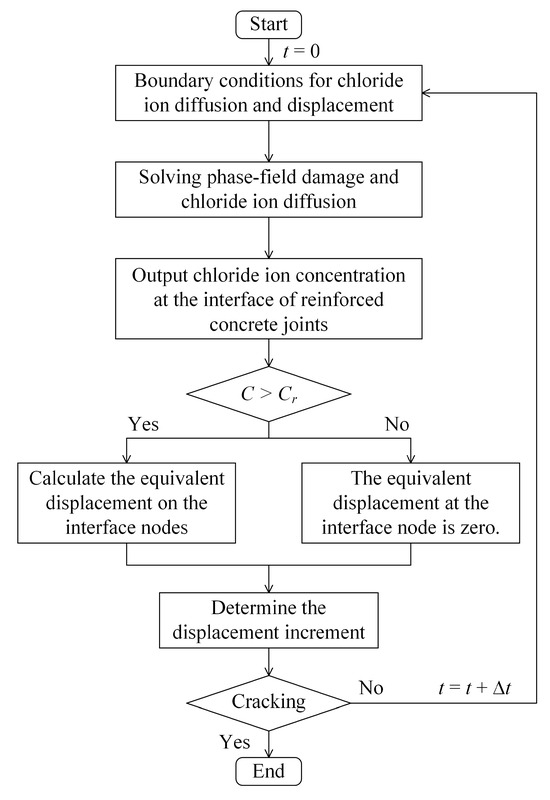
Figure 3.
Flowchart of the chloride salt diffusion–fracture phase field coupling analysis process.
- (a)
- Establish the reinforced concrete model, set the initial time t = 0, and define the time increment step Δt.
- (b)
- Apply the initial boundary conditions for chloride concentration and displacement, and solve for phase-field damage evolution and chloride diffusion at the current time increment.
- (c)
- Store the chloride concentration values at the steel–concrete interface nodes into a Common block in Fortran for data exchange.
- (d)
- Check whether the chloride concentration at the interface nodes reaches the critical threshold for steel corrosion.
- (e)
- If the threshold is reached, record the initiation time of steel corrosion expansion. Then, compute the corrosion level of the reinforcement at the interface nodes based on the local chloride concentration, and determine the corresponding equivalent radial displacement δcorr. Before the threshold is reached, the equivalent radial displacement δ at interface nodes is set to zero.
- (f)
- Within the current time increment, impose the equivalent radial displacement δ at the interface nodes through the Abaqus Disp subroutine, thereby updating the displacement boundary conditions. The coupled phase-field damage evolution and chloride diffusion analyses are then performed via the UEL and UMAT subroutines, yielding the damage distribution and chloride concentration field in the reinforced concrete model. The updated chloride concentrations at the interface nodes are stored back into the Common block for subsequent iterations.
- (g)
- Steps (d)–(f) are repeated iteratively. Through the coordinated operation of the UEL and UMAT subroutines with Fortran-based data transfer and processing at each time increment, the complete simulation of chloride-induced corrosion damage in reinforced concrete is achieved.
5. Numerical Examples
5.1. Failure Simulation of a Single Central Rebar in Reinforced Concrete
In the mesoscopic model of reinforced concrete shown in Figure 4, the concrete cover thickness De is 30 mm, and the diameter of the central rebar is 16 mm. The chloride ion concentration boundary condition Cs = 3% is applied only to the upper surface of the concrete slab. The critical chloride concentration for rebar corrosion is Cr = 0.1%, and the rebar corrosion process is simulated using an equivalent displacement loading method. The numerical model includes aggregates, mortar and ITZ. The specific values of these components can be found in reference [27]. The material parameters of the aggregates are: Elastic modulus E is , Poisson’s ratio ν is 0.16. The material parameters of the mortar are: Elastic modulus E is , Poisson’s ratio ν is 0.22, Tensile strength ft is 2.2 MPa, Fracture energy G0 is 0.072 N/mm, Diffusion coefficient D0 is mm2/s. The material parameters of the ITZ are Elastic modulus E is , Poisson’s ratio ν is 0.2, Tensile strength ft is 1.0 MPa, Fracture energy G0 is 0.021 N/mm, Diffusion coefficient D0 is mm2/s. For different phases, the grid size h is set to 0.5 mm and the length scale l is set to 2.5 mm. When placing the aggregates, the quantity of aggregates with different radii can be calculated based on Fuller’s parabolic gradation curve. The expression is as follows:
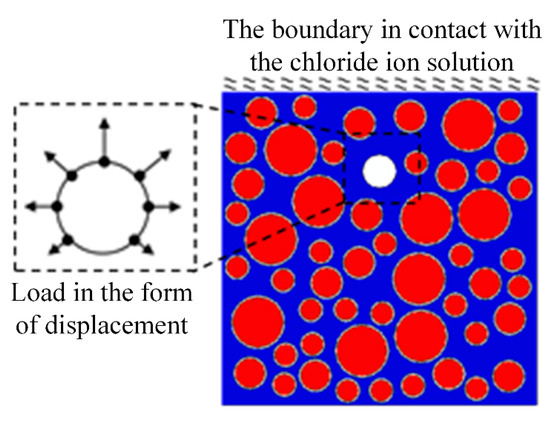
Figure 4.
Geometric model and boundary diagram of reinforced concrete.
In Equation (66), Pi (%) represents the passing rate of a sieve with an aperture of di (mm), where di is the particle size of each grade of aggregate, and Dmax (mm) is the maximum particle size of the aggregate. Due to the wide range of particle sizes of the aggregate in concrete, based on the Fuller curve, three equivalent aggregate particle sizes were adopted, namely 10 mm, 15 mm, and 25 mm. A total of 56 circular equivalent coarse aggregates were placed, accounting for approximately 45% of the total volume. In this study, the other aggregate distributions were also determined according to the Fuller curve.
Figure 5 illustrates the process of chloride-induced concrete cracking at the mesoscale under coupled conditions. After 38 months of exposure to the chloride environment, damage begins to appear at the interface between the aggregate and mortar above the rebar. As time progresses and the degree of rebar corrosion intensifies, the surrounding concrete experiences increasing tensile stress, leading to the formation of three primary damage zones radiating outward from the rebar. These damage zones gradually evolve into cracks. Among them, the crack above the rebar merges with the crack propagating inward from the upper surface of the concrete, forming a through-crack, as shown in crack path 1 in Figure 5d. Meanwhile, the crack on the right side of the rebar propagates outward, as indicated by crack path 2, resulting in the spalling of the upper-right protective layer. Simultaneously, a crack initiates at the lower-left side of the rebar and expands, following crack path 3. Notably, in addition to the three cracks surrounding the rebar, a surface crack appears on the left boundary of the concrete and propagates inward, as illustrated by crack path 4, ultimately leading to the detachment of the upper-left protective layer. These results indicate that in the chloride environment, rebar corrosion products not only induce cracking in the concrete surrounding the rebar but also indirectly cause damage in other parts of the structure, leading to protective layer spalling and failure, which severely impacts the service life and structural integrity of reinforced concrete.

Figure 5.
Failure mode of a single central rebar in reinforced concrete.
Additionally, as shown in Figure 6, the mesoscale simulation results from this study are compared with existing experimental observations and mesoscale numerical simulations based on damage mechanics. From Figure 6a, it can be observed that three primary cracks develop within the concrete surrounding the rebar, which closely matches the three prominent cracks observed around the rebar in Figure 6b. Although there are some discrepancies in crack propagation angles compared to the experimental results, these differences arise due to the randomly distributed aggregates in the mesoscale concrete numerical model, which do not exactly match the aggregate distribution in the physical experiments. Since aggregate distribution affects the crack propagation direction around the rebar, minor deviations in crack angles occur. However, the overall crack evolution trend remains consistent with the experimental findings, demonstrating that the computed mesoscale concrete cracking pattern aligns well with the experimental results reported by Tran [28]. By comparing the numerical results with experimental data, the proposed diffusion-mechanical coupled phase field analysis method is validated as an effective approach for accurately simulating the complex process of chloride corrosion, rebar expansion, and concrete cracking at the mesoscale. Furthermore, the numerical results are also compared with the mesoscale rebar-induced damage simulations based on damage mechanics [29], as shown in Figure 6c. The comparison indicates that the proposed phase field analysis method provides a more accurate representation of the complex crack propagation paths within concrete, capturing the tortuous nature of cracks during their actual growth. At the mesoscale, this approach offers a more detailed insight into the failure process of reinforced concrete structures in the chloride environment and enables a more precise prediction of the spalling patterns in concrete protective layers.
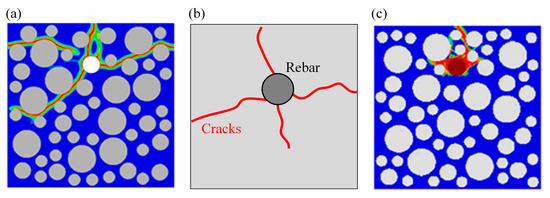
Figure 6.
The comparison of a single central rebar in reinforced concrete between (a) the simulation result in this study, (b) the experiment result in [28] and (c) the simulation result of damage mechanics in [29].
5.2. Failure Simulation of a Single Corner Rebar in Reinforced Concrete
This section analyzes the damage and failure process of concrete caused by rebar corrosion expansion in a corner region under the chloride environment. For simplification, only the concrete corner region is modeled. The geometric model and boundary conditions of the reinforced concrete are shown in Figure 7, where the concrete cover thickness De is 30 mm, and the rebar diameter is 16 mm. The rebar corrosion process is simulated by equivalent displacement loading. Chloride ion concentration boundaries Cs = 3% are applied to the top and right surfaces of the concrete slab, while the left and bottom boundaries are fixed. The critical chloride concentration for rebar expansion is denoted as Cr = 0.1%. The numerical simulation parameters remain the same as those in the previous section.
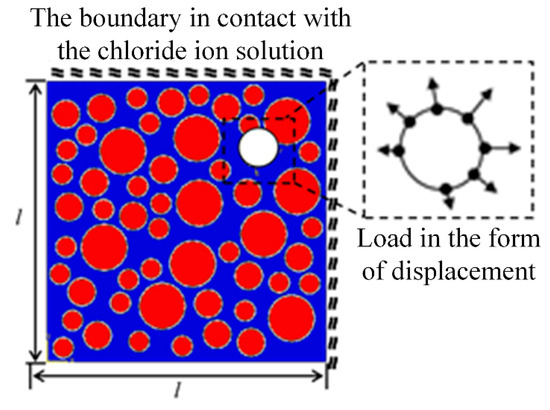
Figure 7.
Geometric model and boundary diagram of corner reinforced concrete.
Figure 8 illustrates the crack propagation and failure process in the concrete corner region. It can be observed that after approximately 38.1 months of exposure, the right-side protective layer of the concrete is the first to crack, while the upper protective layer remains almost undamaged at this stage. This is because, during the random placement of aggregates, a higher concentration of aggregates was placed above the rebar compared to the right side. As shown in Figure 9, after approximately 15.0 months of exposure, the chloride ion concentration on the right side of the rebar reaches the critical corrosion threshold first, causing the right side of the rebar to start corroding and expanding earlier. In contrast, the chloride ion concentration in the upper region takes about 1.3 months longer to reach the critical corrosion threshold. As a result, a greater amount of corrosion products accumulate on the right side, leading to higher tensile stress in the right-side protective layer. Once the tensile stress exceeds the tensile strength of the concrete, cracking first occurs on the right-side surface. With increasing exposure time and further chloride penetration, the chloride concentration above the rebar eventually reaches the critical corrosion level. Consequently, damage begins to appear at the aggregate-mortar interface above the rebar, which then gradually evolves into cracks. Based on this analysis, the following conclusions can be drawn: For shorter chloride diffusion times, aggregates serve as a diffusion barrier, influencing both the onset time of rebar corrosion and the crack propagation behavior within the concrete. Moreover, compared to the case of centrally located rebar corrosion, the cracks around the corner rebar penetrate the surrounding concrete approximately 6.1 months earlier, indicating that concrete in corner regions is more susceptible to cracking.
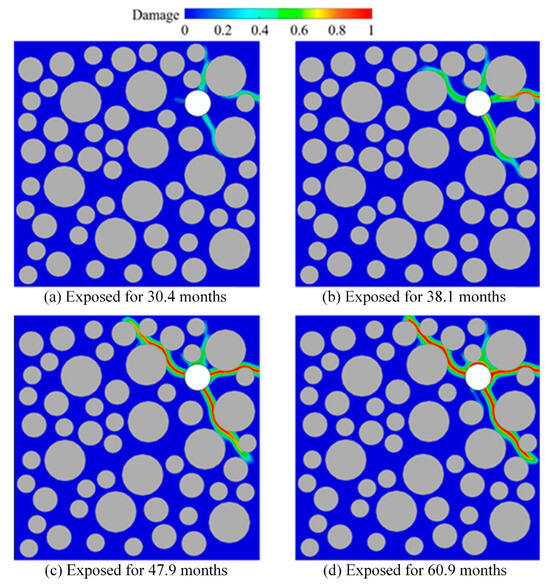
Figure 8.
Failure mode of a single corner rebar in reinforced concrete.
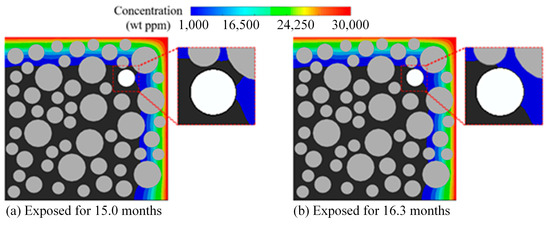
Figure 9.
Diagram of the critical rust expansion concentration at the rebar surface.
As shown in Figure 10, the mesoscale simulation results from this section are compared with existing experimental observations and mesoscale numerical simulations based on damage mechanics. In Figure 10a, three primary cracks are observed in the concrete surrounding the corner rebar. Comparing these results with the experimental study conducted by Fischer [30]. As shown in Figure 10b, it can be seen that the crack propagation paths and angles in the corner region obtained from the simulation are generally consistent with the experimental findings. Furthermore, a comparison with the mesoscale damage mechanics-based simulation results for corner-region concrete indicates that the proposed phase field analysis method effectively reproduces the complex processes of crack initiation, propagation, and tortuous development within concrete. The direction and trend of crack propagation align more closely with experimental results.
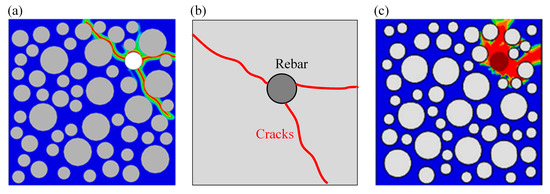
Figure 10.
The comparison of a single corner rebar in reinforced concrete between (a) the simulation result in this study, (b) the experiment result in [30] and (c) the simulation result of damage mechanics in [29].
5.3. Failure Simulation of Multi-Rebar Reinforced Concrete
In this section, a mesoscale numerical simulation is conducted to investigate the chloride corrosion and expansion-induced damage in multi-rebar reinforced concrete. The mesoscale concrete model containing multiple parallel rebars is shown in Figure 11, where the coarse aggregate volume fraction is 45%. The concrete cover thickness De is 30 mm, and the rebar diameter is 16 mm. The clear spacing between rebars is set as S = 32 mm, S = 64 mm, and S = 96 mm. The rebar corrosion process is simulated by equivalent displacement loading. A chloride ion concentration boundary condition Cs = 3% is applied to the top surface of the concrete slab, while the chloride ion flux on all other boundaries is set to zero. The critical chloride concentration for rebar expansion is denoted as Cr = 0.1%, and the bottom boundary is fixed. The numerical simulation parameters remain consistent with those used in the previous two sections.

Figure 11.
Diagram of geometry and boundary conditions of multi-rebar reinforced concrete.
The failure process of concrete cracking caused by uneven corrosion of the multi-reinforced concrete at S = 32 mm is shown in Figure 11. As seen in Figure 12a, damage first appears at the interface between the aggregate and the concrete mortar. As the corrosion of the rebar deepens, the continuous expansion of corrosion products leads to surface deformation. Surface cracks initially emerge at the tops of the two corner rebars and then propagate inward into the concrete, with the concrete cover in the corner area showing the first signs of spalling, as shown in Figure 12b. Subsequently, cracks from the middle rebar extend towards the corner rebar, while cracks around the corner rebar spread towards the middle rebar. As the corrosion of the rebar intensifies, as shown in Figure 12c, cracks appear on both sides of the concrete cover and extend towards the surfaces, leading to spalling of the concrete corners. Internal cracks between the reinforcing bars penetrate, causing concrete delamination. Finally, as shown in Figure 12d, cracks begin to develop near the corner rebar, extending towards the lower side, causing further detachment of the concrete cover and severe structural damage. It is evident that the cracking in the corner region is more severe than in the central region of the concrete.
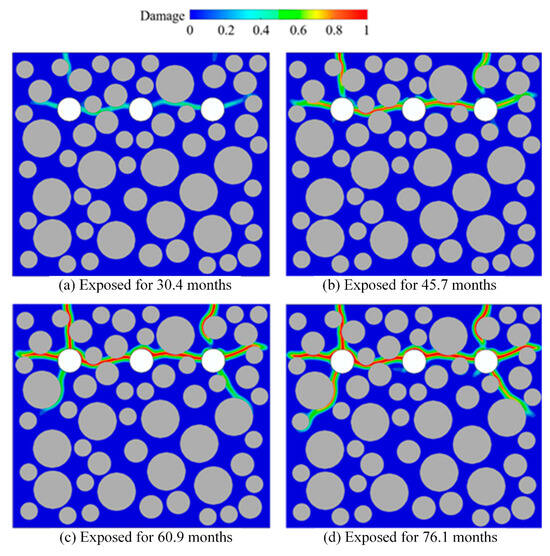
Figure 12.
Failure mode of multi-rebar reinforced concrete, S = 32 mm.
Figure 13 shows the corrosion conditions of the three rebars inside the concrete after 76.1 months of exposure, considering the coupling effects. It can be observed that the corrosion of the two rebars on the left and right, near the outer part of the concrete boundary, is more severe, indicating that the outer concrete cover in the corner area is more prone to spalling. A comparison between the two-side rebars and the central rebar reveals that the corrosion of the side rebars is more pronounced. This analysis result is consistent with the crack distribution shown in Figure 12, where the internal damage to the concrete near the corner rebar is more severe than that near the central rebar. The clear distance between rebars is an important parameter in the design of reinforced concrete structures. Figure 14 and Figure 15 show the cracking and failure modes of multi-reinforced concrete with clear distances of 64 mm and 96 mm, respectively. Comparing these results with the case of S = 32 mm, it can be seen that in all three cases, surface cracks first appear on the concrete surface above the two corner rebars, leading to corner spalling. Additionally, side cracks connect to form horizontal cracks, resulting in delamination of the reinforced concrete and failure of the concrete cover. It is worth noting that in Figure 15d, crack bridging is observed. Figure 16 shows the comparison of the time when cracks appear on the concrete surface under different clear spacings of reinforcing bars. When S = 32 mm, cracking of the concrete surface occurs after 45.7 months of exposure. As the clear distance increases, the surface of the concrete member with a clear distance of 64 mm cracks after 49.5 months of exposure, delaying the cracking time by 3.8 months compared to the concrete with S = 32 mm. The surface of the concrete member with a clear distance of 96 mm cracks after 50.2 months of exposure, delaying the cracking time by 4.5 months compared to the concrete with S = 32 mm. Furthermore, it is observed that for the concrete with S = 32 mm, the rebar is already penetrated by cracks before surface cracking occurs, with delamination occurring earlier than the surface cracking. However, as the clear distance increases, delamination only appears after the concrete surface cracks. These results indicate that although delamination occurs in concrete under chloride salt corrosion, increasing the clear distance can maximize the utilization of rebar material and extend the service life of reinforced concrete structures in chloride environments. Figure 17 presents a comparison between the simulation results of this study, existing experimental observations, and the micro-scale simulation results based on damage mechanics. As shown in Figure 17a, the cracks inside the concrete simulated in this study are mainly distributed on both sides of each rebar and the upper parts of the two corner rebars, with horizontal through cracks formed between the rebars. This is consistent with the experimental results obtained by Dong [31], as shown in Figure 17b. In comparison with the numerical simulation results based on damage mechanics [29], as shown in Figure 17c, it can be observed that the coupled analysis method used in this study better simulates the cracking process of concrete caused by corrosion of the multiple rebars at the micro-scale and the interactions between the cracks within the concrete.
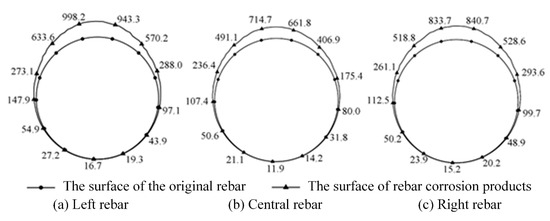
Figure 13.
Diagram of rebar corrosion expansion after 76.1 months of exposure (μm), S = 32 mm.
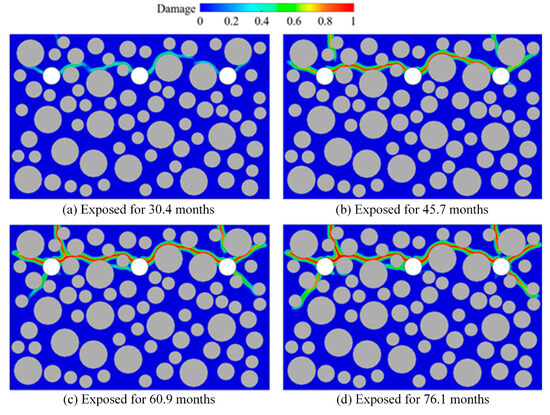
Figure 14.
Failure mode of multi-rebar reinforced concrete, S = 64 mm.
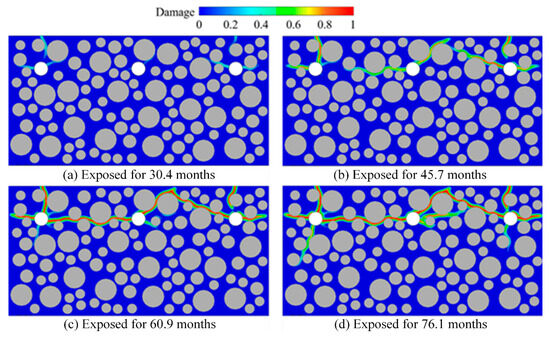
Figure 15.
Failure mode of multi-rebar reinforced concrete, S = 96 mm.
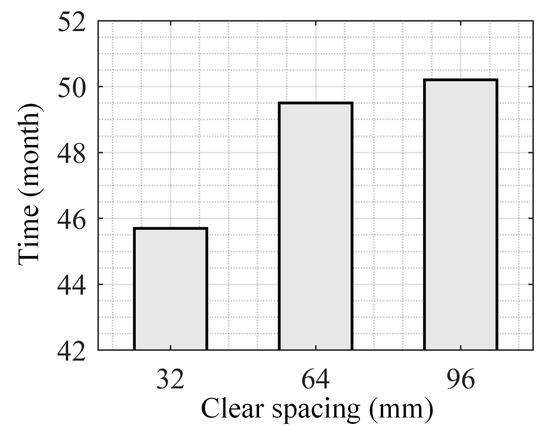
Figure 16.
The time when cracks appear on the concrete surface under different clear spacings of reinforcing bars.

Figure 17.
The comparison of multi-rebar reinforced concrete between (a) the simulation result in this study, (b) the experiment result in [31] and (c) the simulation result of damage mechanics in [29].
6. Conclusions
In this study, a meso-scale diffusion-mechanical coupled phase field model is established for the failure analysis of reinforced concrete under chloride erosion. The model accounts for the typical mechanical behavior in multi-physical fields, such as chloride ion diffusion, rebar rust expansion and concrete damage. The whole process from chloride ion diffusion, rebar corrosion to concrete cracking is simulated with high precision. In addition, the random aggregate meso-structure is introduced into the numerical model, which breaks through the bottleneck of the traditional homogeneous model, making it difficult to describe the tortuous crack propagation. Through the systematic verification of multiple sets of numerical simulations and experiments, the following conclusions are drawn:
(1) The proposed diffusion-mechanical coupled phase field model also takes into account the coupling mechanism of chloride ion diffusion, rebar corrosion and concrete damage. Compared with the traditional damage mechanics model, the prediction accuracy of crack propagation path is greatly improved, and the predicted rust onset time error is smaller.
(2) The crack preferentially expands along the aggregate-mortar interface. In addition, due to the bidirectional penetration effect, the cracking time of the protective layer of the corner rebar is significantly shorter than that of the middle rebar, which reveals the microscopic mechanism of the priority failure of the corner concrete in practical engineering.
(3) With the increase in the net distance of the rebars, the time lag of concrete failure and spalling is delayed. Therefore, in the design of concrete structures, it is possible to extend the service life of reinforced concrete structures in chlorine salt environment by increasing the clear distance between the rebars and making better use of the rebars under the premise of ensuring the synergistic effect of the rebars and concrete.
(4) While the present 2D mesoscale simulations provide representative insights, they do not capture the full stochastic variability of aggregate placement; future work will incorporate 3D analyses and Monte Carlo simulations to enhance robustness.
(5) Apart from the corrosion of the rebars caused by chloride ions, adverse conditions such as sulfate erosion and freeze–thaw cycles can also lead to deterioration of reinforced concrete. Incorporating these complex factors into the current model is one of the key focuses of subsequent research.
Author Contributions
Conceptualization, J.Y. and L.G.; methodology, J.Y. and L.G.; software, Q.Z. and J.R.; validation, J.Y., Q.Z. and L.G.; formal analysis, Q.Z. and J.R.; investigation, J.Y., J.R. and L.G.; resources, J.Y. and L.G.; data curation, J.Y., Q.Z., J.R. and L.G.;writing—original draft preparation, J.R. and L.G.; writing—review and editing, J.R. and L.G.; visu-alization, J.Y. and Q.Z.; supervision, J.Y. and Q.Z.; project administration, J.Y. and L.G.; funding acquisition, L.G. All authors have read and agreed to the published version of the manuscript.
Funding
Financial support by the Fundamental Research Funds for the Central Universities (No. 2242022k30062, 2242024K30007), and Jiangsu Provincial Department of Science and Technology (BM2023013) is gratefully acknowledged.
Data Availability Statement
Data is contained within the article. The original contributions presented in this study are included in the article. Further inquiries can be directed to the corresponding author(s).
Conflicts of Interest
Author Jingqiu Yang was employed by the company Yunnan Power Grid Co., Ltd., and author Quanjun Zhu was employed by the company China Electric Power Research Institute. The remaining authors declare that the research was conducted in the absence of any commercial or financial relationships that could be construed as a potential conflict of interest.
References
- Pradelle, S.; Thiéry, M.; Baroghel-Bouny, V. Comparison of existing chloride ingress models within concretes exposed to seawater. Mater. Struct. 2016, 49, 4497–4516. [Google Scholar] [CrossRef]
- Yu, B.; Cheng, D.; Shi, C.S.; Wei, H.X. Comparison of Prediction Models for Concrete Carbonation. Adv. Mater. Res. 2013, 842, 87–90. [Google Scholar]
- Poursaee, A.; Ross, B. The Role of Cracks in Chloride-Induced Corrosion of Carbon Steel in Concrete-Review. Corros. Mater. Degrad. 2022, 3, 258–269. [Google Scholar] [CrossRef]
- Savija, B.; Lukovic, M.; Pacheco, J.; Schlangen, E. Cracking of the concrete cover due to reinforcement corrosion: A two-dimensional lattice model study. Constr. Build. Mater. 2013, 44, 626–638. [Google Scholar] [CrossRef]
- Zhang, Z.Q.; Li, Y.L.; Zhu, X.Y.; Liu, X.H. Meso-scale corrosion expansion cracking of ribbed reinforced concrete based on a 3D random aggregate model. J. Zhejiang Univ. Sci. A 2021, 22, 924–940. [Google Scholar] [CrossRef]
- Zhao, Y.X.; Jin, W.L. Modeling the amount of steel corrosion at the cracking of concrete cover. Adv. Struct. Eng. 2006, 9, 687–696. [Google Scholar] [CrossRef]
- Pantazopoulou, S.J.; Papoulia, K.D. Modeling cover-cracking due to reinforcement corrosion in RC structures. J. Eng. Mech. ASCE 2001, 127, 342–351. [Google Scholar] [CrossRef]
- Oh, B.H.; Jang, B.S. Chloride diffusion analysis of concrete structures considering effects of reinforcements. Aci Mater. J. 2003, 100, 143–149. [Google Scholar]
- Angst, U.M. Challenges and opportunities in corrosion of steel in concrete. Mater. Struct. 2018, 51, 4. [Google Scholar] [CrossRef]
- Grymin, W.; Gawin, D.; Koniorczyk, M.; Pesavento, F. Experimental and numerical investigation of the alkali-silica reaction in the cement-based materials. Arch. Civ. Mech. Eng. 2018, 18, 1698–1714. [Google Scholar] [CrossRef]
- Sanz, B.; Planas, J.; Sancho, J.M. An experimental and numerical study of the pattern of cracking of concrete due to steel reinforcement corrosion. Eng. Fract. Mech. 2013, 114, 26–41. [Google Scholar] [CrossRef]
- Zhang, P.; Dai, J.G.; Das, C.S.; Zheng, J.J. A fully coupled meso-scale electro-chemo-mechanical phase field method for corrosion-induced fracture in concrete. Int. J. Solids Struct. 2023, 267, 112165. [Google Scholar] [CrossRef]
- Aranson, I.S.; Kalatsky, V.A.; Vinokur, V.M. Continuum field description of crack propagation. Phys. Rev. Lett. 2000, 85, 118–121. [Google Scholar] [CrossRef]
- Karma, A.; Kessler, D.A.; Levine, H. Phase-field model of mode III dynamic fracture. Phys. Rev. Lett. 2001, 87, 045501. [Google Scholar] [CrossRef] [PubMed]
- Henry, H.; Levine, H. Dynamic instabilities of fracture under biaxial strain using a phase field model. Phys. Rev. Lett. 2004, 93, 105504. [Google Scholar] [CrossRef] [PubMed]
- Francfort, G.A.; Marigo, J.J. Revisiting brittle fracture as an energy minimization problem. J. Mech. Phys. Solids 1998, 46, 1319–1342. [Google Scholar] [CrossRef]
- Bourdin, B.; Francfort, G.A.; Marigo, J.J. Numerical experiments in revisited brittle fracture. J. Mech. Phys. Solids 2000, 48, 797–826. [Google Scholar] [CrossRef]
- Buliga, M. Energy minimizing brittle crack propagation. J. Elast. 1998, 52, 201–238. [Google Scholar] [CrossRef]
- Wu, J.Y. A geometrically regularized gradient-damage model with energetic equivalence. Comput. Methods Appl. Mech. Eng. 2018, 328, 612–637. [Google Scholar] [CrossRef]
- Wu, J.; Cervera, R.M. Strain Localization and Failure Mechanics for Elastoplastic Damage Solids; CIMNE: Barcelona, Spain, 2014. [Google Scholar]
- Tanné, E.; Li, T.; Bourdin, B.; Maurini, C. Crack nucleation in variational phase-field models of brittle fracture. J. Mech. Phys. Solids 2018, 110, 80–99. [Google Scholar] [CrossRef]
- Jung, W.J.; Yoon, Y.S.; Sohn, Y.M. Predicting the remaining service life of land concrete by steel corrosion. Cem. Concr. Res. 2003, 33, 663–677. [Google Scholar] [CrossRef]
- Gérard, B.; Marchand, J. Influence of cracking on the diffusion properties of cement-based materials: Part I: Influence of continuous cracks on the steady-state regime. Cem. Concr. Res. 2000, 30, 37–43. [Google Scholar] [CrossRef]
- Gerasimov, T.; De Lorenzis, L. On penalization in variational phase-field models of brittle fracture. Comput. Methods Appl. Mech. Eng. 2019, 354, 990–1026. [Google Scholar] [CrossRef]
- Miehe, C.; Welschinger, F.; Hofacker, M. Thermodynamically consistent phase-field models of fracture: Variational principles and multi-field FE implementations. Int. J. Numer. Methods Eng. 2010, 83, 1273–1311. [Google Scholar] [CrossRef]
- Simo, J.C.; Ju, J.W. Strain-based and stress-based continuum damage models—1. Formulation. Int. J. Solids Struct. 1987, 23, 821–840. [Google Scholar] [CrossRef]
- Hu, X.F.; Xu, H.; Xi, X.; Zhang, P.; Yang, S. Meso-scale phase field modelling of reinforced concrete structures subjected to corrosion of multiple reinforcements. Constr. Build. Mater. 2022, 321, 126376. [Google Scholar] [CrossRef]
- Tran, K.K.; Nakamura, H.; Kawamura, K.; Kunieda, M. Analysis of crack propagation due to rebar corrosion using RBSM. Cem. Concr. Compos. 2011, 33, 906–917. [Google Scholar] [CrossRef]
- Zhang, Q. Study on Coupling Analysis Method of Chloride Ion Erosion and Rust Expansion Cracking Process of Reinforced Concrete. Ph.D. Thesis, Southeast University, Nanjing, China, 2018. [Google Scholar]
- Fischer, C. Auswirkungen der Bewehrungskorrosion auf den Verbund Zwischen Stahl und Beton; Beuth Verlag GmbH: Berlin, Germany, 2012. [Google Scholar]
- Dong, W.; Murakami, Y.; Oshita, H.; Suzuki, S.; Tsutsumi, T. Influence of Both Stirrup Spacing and Anchorage Performance on Residual Strength of Corroded RC Beams. J. Adv. Concr. Technol. 2011, 9, 261–275. [Google Scholar] [CrossRef]
Disclaimer/Publisher’s Note: The statements, opinions and data contained in all publications are solely those of the individual author(s) and contributor(s) and not of MDPI and/or the editor(s). MDPI and/or the editor(s) disclaim responsibility for any injury to people or property resulting from any ideas, methods, instructions or products referred to in the content. |
© 2025 by the authors. Licensee MDPI, Basel, Switzerland. This article is an open access article distributed under the terms and conditions of the Creative Commons Attribution (CC BY) license (https://creativecommons.org/licenses/by/4.0/).